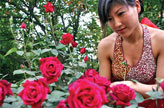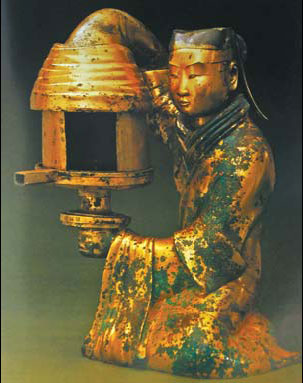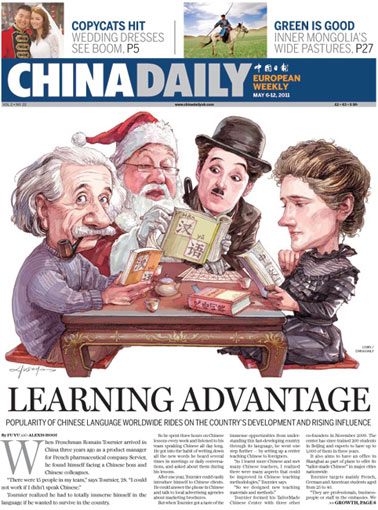Heritage
Shining some light on oil lamps
Updated: 2011-04-26 07:55
By Cheng Anqi (China Daily)
|
The gilded bronze human-shaped lamp of the Western Han Dynasty, at Hebei Provincial Museum. Provided to China Daily |
EDITOR's Note: Every week we look at a work of art or a cultural relic that puts the spotlight on China's heritage.
Pollution control and energy conservation may be the buzzwords of the 21st century, but hundreds of years ago, the Chinese seemed to know a thing or two about them.
British biochemist and scholar of Chinese studies Joseph Needham (1900-1995), in his book Science and Civilization in China, says the oil porcelain lamps of the Tang and Song (AD 960-1297) dynasties were precursors of today's energy-conserving lighting devices.
The base of these lamps was filled with water which helped lower the temperature of the oil and conserve its usage by 25-30 percent.
But the design of the gilded bronze human-shaped lamp of the Western Han Dynasty (206 BC-AD 24) is even more ingenious.
Unearthed in Mancheng county, Hebei province, in 1968, the lamp is one of the most treasured pieces in the collection of Hebei Provincial Museum, and was on display at the Hebei Pavilion of Shanghai World Expo 2010.
The approximately 48 cm high lamp features a kneeling court maid carrying a gold-plated lamp in her hands.
Wearing her hair up in a chic chignon and sporting an elegant, long-sleeved gown, the maid holds the lamp with the right arm while the left hand carries the lamp panel.
The maid's right arm actually serves as channel for the smoke released by the flame, experts say.
The smokes enters the hollow body down to where it gets trapped in water.
 |
The lamp's clever design also allows for the best reflection of light, explains Zheng Shaozong, an expert from Hebei Cultural Relics Research Institute.
Meanwhile, it was not until the 18th century that people in Western countries began to reduce soot pollution by improving lamp design, according to Zheng.
The Western Han Dynasty lamp is detachable with each part - lamp panel, lamp holder and the right arm of the maid - cast separately.
A rod in the center of the lamp panel was where the candle or wick was fixed. The lampshade and the panel can be freely rotated to adjust the quantity of light.
Chen Lusheng, deputy director of the National Museum of China, has been collecting oil lamps for over 30 years. In 1998, he founded a private museum specialized in ancient Chinese oil lamps, in Yangzhong, Jiangsu province.
The collection includes 1,000 kinds of lamps belonging to different historical periods.
"Each lamp carries a rich message of Chinese culture and civilization," says Chen who is better known as a historian of New China art.
The earliest lamps were similar in appearance to a porcelain food container called dou, with an oil tray on top connected by a column to the base.
The designs of oil lamps became more complex after the Han Dynasty (206 BC-AD 220), and were popular among common folk.
The Ming (1368-1644) and Qing (1644-1911) dynasties saw the most glorious period for lamps, with lamps made of glass and enamel making their appearance.
Into the 1900s, diesel began to replace animal fat and vegetable oil as fuel. The emergence of incandescent lamps finally brought the period of oil-lamp use to an end.
E-paper

War of the roses
European Chinese rose growers are beating their Chinese rivals at their own game
High-tech park gets big boost
At the source
Merchant of Venice
Specials

Sino-US Dialogue
China and the US hold the third round of the Strategic and Economic Dialogue on May 9-10 in Washington.

Drunk driving
Drunk drivers face a detention for one to six months and a revokation of their drivers' license.

V-Day parade
A military parade marking the 66th anniversary of the Soviet victory over Nazi.

